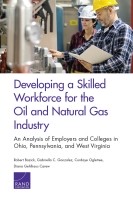| 来源类型 | Research Reports
|
| 规范类型 | 报告
|
| DOI | https://doi.org/10.7249/RR2199
|
| ISBN | 9780833099471
|
| 来源ID | RR-2199-NSF
|
| Developing a Skilled Workforce for the Oil and Natural Gas Industry: An Analysis of Employers and Colleges in Ohio, Pennsylvania, and West Virginia |
| Robert Bozick; Gabriella C. Gonzalez; Cordaye Ogletree; Diana Gehlhaus Carew
|
| 发表日期 | 2017
|
| 出版年 | 2017
|
| 页码 | 106
|
| 语种 | 英语
|
| 结论 |
Employers Want Workers with Both Specific and General Managerial Skills- More than half of employers have high-priority occupations that require at least five years of previous work experience.
- Workers who can think critically and creatively in the context of their work, solve work-based problems, and make sound decisions at work are highly sought, as are workers who understand the fundamentals of administration and management.
Colleges Do Not Appear to Have Curricular Structures Conducive to Occupational Education- Most colleges in the region do not explicitly incorporate these into their oil and natural gas–related degree programs.
- Though most colleges in the tristate region report supporting students getting jobs in specific occupations within the oil and natural gas industry, few have stackable credential programs and less than half of courses aimed at future workers in the oil and natural gas industry use contextualized instruction.
- Stackable credential programs increasingly are receiving attention from workforce development policymakers and practitioners because they allow workers to obtain occupation-specific knowledge and skills in an efficient, flexible structure and format.
- Contextualized instruction uses occupational applications to teach basic academic skills (and vice versa) in such a way that the student learns both simultaneously. The majority of courses offered in oil and natural gas--related departments in the tristate region use contextualized instruction less than half of the time.
There Is a Disconnect Between Employers and Colleges- The majority of employers do not communicate results of workforce planning with colleges, and few employers provide deep or continual instructional or curricular support to colleges.
- Both colleges and employers point to each other's unwillingness and lack of time as key barriers to partnering.
|
| 摘要 |
- Colleges need to adjust programming so that it fits better with the agile, flexible, and nonlinear nature of workforce development.
- Colleges should prioritize the development of work-based learning opportunities for students, such as internships or cooperatives, which provide hands-on experiential learning at a worksite.
- Employers will need to become more flexible in hiring and placement decisions to keep pace with the labor market's needs for an agile workforce.
- In addition to community colleges and private training institutes, include four-year colleges and universities and other stakeholders, such as workforce investment boards and industry trade associations, in strategies for workforce development and planning.
|
| 主题 | Continuing Education
; Human Capital Investments
; Natural Gas
; Occupational Training
; Ohio
; Pennsylvania
; Petroleum
; Postsecondary Education
; STEM Education
; West Virginia
; Workforce Development
; Workforce Management
|
| URL | https://www.rand.org/pubs/research_reports/RR2199.html
|
| 来源智库 | RAND Corporation (United States)
|
| 引用统计 |
|
| 资源类型 | 智库出版物
|
| 条目标识符 | http://119.78.100.153/handle/2XGU8XDN/108691
|
推荐引用方式
GB/T 7714 |
Robert Bozick,Gabriella C. Gonzalez,Cordaye Ogletree,et al. Developing a Skilled Workforce for the Oil and Natural Gas Industry: An Analysis of Employers and Colleges in Ohio, Pennsylvania, and West Virginia. 2017.
|
|
文件名:
|
x1549463256148.jpg
|
|
格式:
|
JPEG
|

|
文件名:
|
RAND_RR2199.pdf
|
|
格式:
|
Adobe PDF
|
除非特别说明,本系统中所有内容都受版权保护,并保留所有权利。